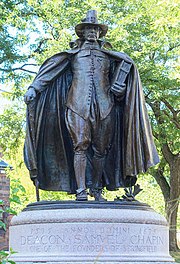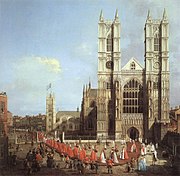History of the Puritans from 1649
| Part of a series on |
| Puritans |
|---|
 |
From 1649 to 1660,
English Interregnum, 1649–1660
Failure of the Presbyterian church, 1649–1654
| Part of a series on the |
| History of the Church of England |
|---|
 |
The
In 1646, the
- In many localities – especially those areas which had been Royalist during the Civil Wars and which had low numbers of Puritans, both the bishops and the Book of Common Prayer were popular, and ministers, as well as their congregations, simply continued to conduct worship in their ordinary way.
- gathered churches.
- Clergymen who favored presbyterianism nevertheless disliked the Erastianelement in the office of "commissioner". Some were thus less than enthusiastic about implementing the Long Parliament's scheme.
- Since the office of bishop had been abolished in the church, with no substitute, there was no one to enforce the new presbyterianism scheme on the church, so the combination of opposition and apathy meant that little was done.
With the abolition of the Act of Uniformity, even the pretense of religious uniformity broke down. Thus, while the Presbyterians were dominant (at least theoretically) within the established church, those who opposed Presbyterianism were in fact free to start conducting themselves in the way they wanted. Separatists, who had previously organized themselves underground, were able to worship openly. For example, as early as 1616, the first English
Many sects were also organized during this time. It is not clear that they should be called "Puritan" sects since they placed less emphasis on the Bible than is characteristic of Puritans, instead insisting on the role of direct contact with the Holy Spirit. These groups included the Ranters, the Fifth Monarchists, the Seekers, the Muggletonians, and – most prominently and most lastingly – the Quakers.
Religious controversies of the Interregnum

The Puritan movement split over issues of ecclesiology in the course of the Westminster Assembly. In the course of the 1650s, the movement became further split in the course of a number of controversies. With no means to enforce uniformity in the church and with freedom of the press, these disputes were largely played out in pamphlet warfare throughout the decade.
Owen–Baxter Debate over the nature of Justification
In 1647,
In 1649, Richard Baxter, the minister of Kidderminster, Worcestershire and who served as chaplain to Colonel Edward Whalley's regiment, published a reply to Owen, entitled Aphorisms of Justification. He argued that the doctrine of unlimited atonement was more faithful to the words of scripture. He invoked the authority of dozens of the Reformers, including John Calvin, in support of his position.
In the course of the 1650s, Owen and Baxter engaged in a series of replies and counter-replies on the topic. At the same time, both men gained followers for their positions. John Owen preached to the Long Parliament the day after the execution of Charles I, and then accompanied
Baxter also gained a following in the 1650s, publishing prolifically after his return to Kidderminster. Two of his books – The Saints' Everlasting Rest (1650) and The Reformed Pastor (1656) – have been regarded by subsequent generations as Puritan classics. Many clergymen came to see Baxter as the leader of the Presbyterians, the largest party of Puritans, in the course of the 1650s.
Socinian controversy
The most prominent Socinian of the 1650s was John Biddle, often known as the "Father of English Unitarianism." Biddle was imprisoned in 1645 and 1646 for publicizing his denials of the Trinity. After being defended in the Long Parliament by Henry Vane the Younger, Biddle was released in 1648. In 1652, he was arrested again after he published an anti-trinitarian catechism. ohn Owen produced several pieces denouncing Biddle's views. However, Cromwell, true to his principle of religious liberty, intervened to ensure that Biddle was not executed, but instead sent to exile on the Isles of Scilly in 1652.
Growth of the sectaries
This section is empty. You can help by adding to it. (January 2011) |
From 1660 to present day
Puritans and the Restoration, 1660
The largest Puritan faction – the Presbyterians – had been deeply dissatisfied with the state of the church under Cromwell. They wanted to restore religious uniformity throughout England and they believed that only a restoration of the English monarchy could achieve this and suppress the sectaries. Most Presbyterians were therefore supportive of the
Shortly after Charles II's return to England, in early 1661, Fifth Monarchists Vavasor Powell and Thomas Venner attempted a coup against Charles II. Thus, elections were held for the Cavalier Parliament in a heated atmosphere of anxiety about a further Puritan uprising.
Nevertheless, Charles II had hoped that the
When the Cavalier Parliament met in May 1661, its first action, largely a reaction to the Fifth Monarchist uprising, was to pass the
The Great Ejection, 1662

In 1662, the Cavalier Parliament passed the
The majority of ministers who had served in Cromwell's state church conformed to the Book of Common Prayer. Members of Cromwell's state church who chose to conform in 1662 were often labeled
Around two thousand Puritan ministers resigned from their positions as Church of England clergy as a consequence. This group included Richard Baxter, Edmund Calamy the Elder, Simeon Ashe, Thomas Case, William Jenkyn, Thomas Manton, William Sclater, and Thomas Watson. After 1662, the term "Puritan" was generally supplanted by "Nonconformist" or "Dissenter" to describe those Puritans who had refused to conform in 1662.
Persecution of Dissenters, 1662–1672
Though expelled from their pulpits in 1662, many of the non-conforming ministers continued to preach to their followers in public homes and other locations. These private meetings were known as
At the same time that the Cavalier Parliament was ratcheting up the legal penalties against religious dissent, there were various attempts from the side of government and bishops, to establish a basis for "comprehension", a set of circumstances under which some dissenting ministers could return to the Church of England. These schemes for comprehension would have driven a wedge between Presbyterians and the group of Independents; but the discussions that took place between Latitudinarian figures in the Church and leaders such as Baxter and Manton never bridged the gap between Dissenters and the "high church" party in the Church of England, and comprehension ultimately proved impossible to achieve.
The Road to Religious Toleration for the Dissenters, 1672–1689
In 1670, Charles II had signed the
The
Later trends
Puritan experience underlay the later
With the start of the
